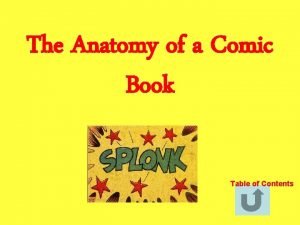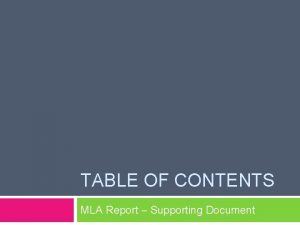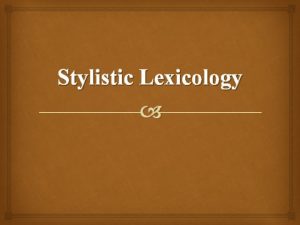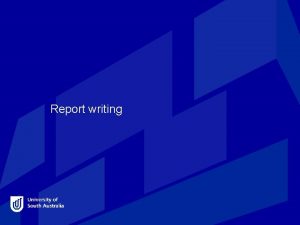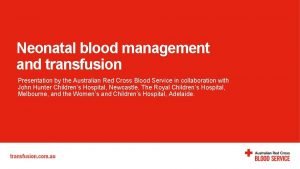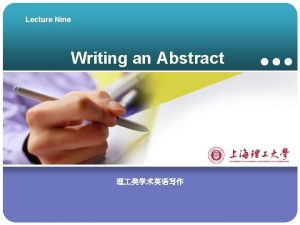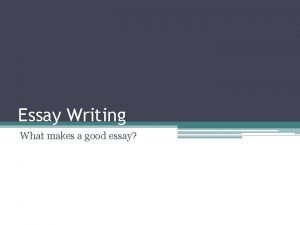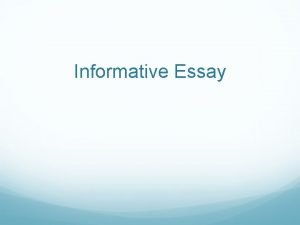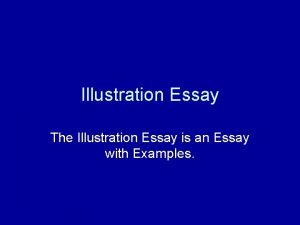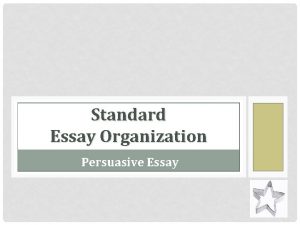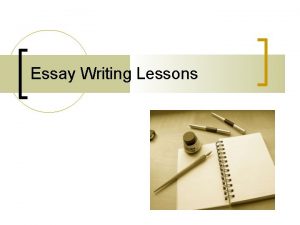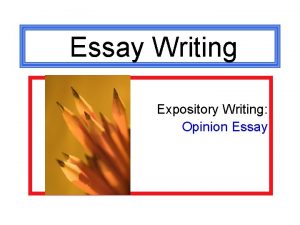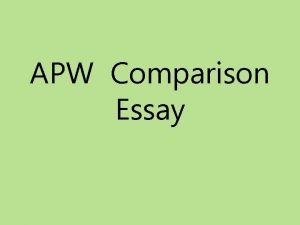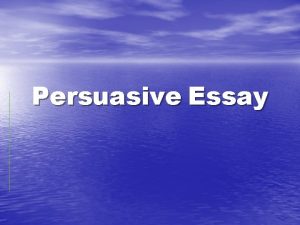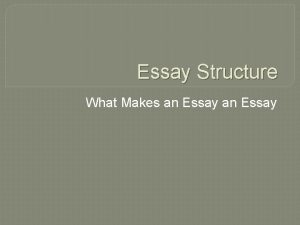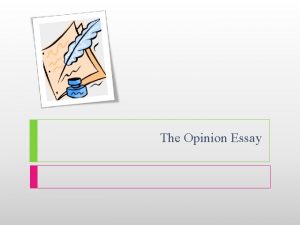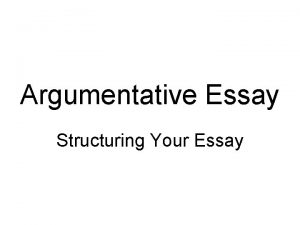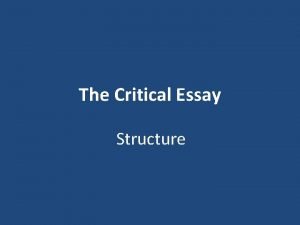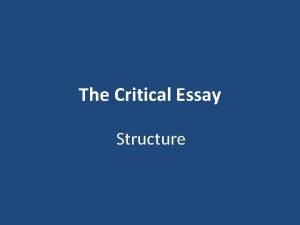The Critical Essay CONTENTS Introduction to Critical Essay





































































- Slides: 69

The Critical Essay

CONTENTS Introduction to Critical Essay writing (slides 3 – 6) A) CHOOSING AN ESSAY TO WRITE ABOUT/ LOOKING AT EXAM QUESTION FORMAT (slides 7 – 19) B) WRITING YOR INTRODUCTION (slides 20 – 26) C) THE SUMMARY PARAGRAPH (slides 27 – 31) D) THE MAIN BODY OF YOUR ESSAY (slides 32 – 41) E) STRUCTURING THE PARAGRAPHS IN THE MAIN BODY OF YOUR ESSAY (slides 42 – 48) F) WRITING ABOUT THE TECHNIQUES IN YOUR CHOSEN TEXT (slides 49 – 60) G) THE CONCLUSION (slides 61 – 68) GENERAL EXAM ADVISE (slide 69)

Introduction n In Critical Essays you have to show your knowledge and understanding of a text that you have studied. n You should also be able to explain some of the ways in which the author achieved what he or she wanted to with that text.

Remember… n In the exam you have to write two essays in 90 minutes. n That’s just 45 minutes each!

What am I being examined on? n Why do the examiners want you to write an essay? What do they want you to prove about your skills? n They are actually looking at four different areas of your essaywriting skill: n A) Understanding means how well you understand know the text you have studied n B) Analysis means being able to examine the way the writer writes and the techniques he or she uses n C) Evaluation means having a personal response to and a personal opinion about what you have read. n D) Expression is how well you use the English language in your writing. This includes your spelling, grammar and punctuation. It also means that your essay has to be well linked together, and that the language you use should be formal.

What will the critical essay paper look like? n As you work through this Powerpoint you will learn to produce essays that display all these skills. n Let’s start by looking at how the Critical Essay exam paper is organised. n It comes in the form of a four-page booklet. n • The front page has the name and date of the exam, and tells you the start and finish times. It will also remind you to, ‘Answer two questions’, and tells you that each is worth up to 25 marks. n • The middle pages contain the essay choices most pupils are most likely to choose from. n • The back page contains essay choices in two categories that not so many pupils study.

A) Choosing an essay to write about/Looking and exam question format

Choosing an essay n The wording of the exam paper changed from the year 2006 onwards, and is a little different from some of the past papers you may see. At the top of the second page you’ll find a general instruction like this: n The following will be assessed: n • the relevance of your essay to the question you have chosen n • your knowledge and understanding of key elements, central concerns and significant details of chosen texts n n • your explanation of ways in which aspects of structure/style/language contribute to the meaning/effect/impact of the chosen texts n • your evaluation of the effectiveness of the chosen texts, supported by detailed and relevant evidence n • the quality and technical accuracy of your writing

Format of paper n This is all just another way of telling you about the skills that the examiners are assessing. n The essay choices are divided into five sections from A to E like this: n Section A — Drama Section B — Prose Section C — Poetry Section D — Film And TV Drama Section E — Language n n Under each of the five headings you will see three essay choices. This means that if you have studied one play, one piece of prose and one poem then there will be nine possible essays for you to pick from. But remember, you only have to write two. n n The two essays you choose must come from different sections of the exam paper.

So how are you going to make your choice?

Wording Of Questions To begin to work this out, we need to look at the way the individual questions are worded. n All the essays tasks follow the same pattern. They are set out in two paragraphs. n Here’s an essay task from a recent exam: n ‘Choose a novel or a short story in which there is an obvious climax or turning point. n Show the writer leads up to this turning point or climax, and say what is its significance for the rest of the story. ’ n

Paragraph 1 Of Question

Paragraph 1 Of Question n To choose which essay to write you’re going to look at just the first paragraph of the essay topic. n As soon as you see these words, you need to run through a quick mental checklist. Let’s assume you go into the exam knowing all the stories and poems in this book.

You can ask yourself: n n n Have I studied a novel? to which the answer would be: No. That doesn’t mean you have to rule out trying this essay. The next thing you need to ask yourself is: Have I studied any short stories? This time the answer is: Yes, three of them: ‘The Test’, ‘Death of a Spinster’ and ‘If I Quench Thee’. So you might be able to write this essay. Now it’s time to focus in even tighter on that first paragraph and look at what kind of short story the examiners want you to write about. So now you need to ask yourself: Is there a climax in any of these stories, or a turning point where things change for at least one of the characters?

This essay question turns out to be quite a good one, because you get three quite positive answers: n n n In ‘The Test’ the climax comes when Marian finally loses her patience and snaps at the driving inspector, giving him the excuse to fail her. In ‘Death of a Spinster’ the climax comes when the unscheduled car kills the main character. In ‘If I Quench Thee’ the climax is when Stern murders Tod. This is also a turning point because Stern goes quickly from being in control of the situation to being arrested for murder.

Paragraph 2 Of Question

Paragraph 2 Of Question n n n It’s time to narrow down your choice. To help you do this, take another look at the words in the second paragraph of the task. This paragraph is where the examiners tell you how they actually want you to tackle the essay. The words of the second paragraph give you instructions that you must follow. If you don’t obey the instructions in paragraph two of the task, you aren’t answering the essay question and you will certainly not pass. For this essay, these words in paragraph 2 are important!!!

Wording Of Paragraph 2 n Now you can narrow down your options by asking yourself: Are there any of the stories that don’t really build up to the climax or turning point? n In fact you could still write about two of the stories. n In both of them the climax you have identified comes near, though not quite at, the end. In ‘The Test’ and ‘If I Quench Thee’ the events of the story lead up to and create the climax. In ‘Death of a Spinster’, however, the climax comes as a surprise after the carefully described details of the woman’s dull life. This makes it not such a good story to write this essay about. n n n n n At this stage you can choose which essay to write by asking yourself: Which story do I know better? Which one have I revised more carefully? Which one do I think I could write about better? Or you could carry on looking through the relevant sections of the exam paper until you find a different essay that appeals to you even more.

NOW TRY THIS… TASK 1 – EXAM QUESTION EXAMPLES

B) Writing your introduction

Writing your introduction n The first paragraph you write in the essay will be your introduction. Whenever you write a literature essay, the same three things should appear in the introduction: n 1 the title of the text you read 2 the name of the author 3 a clear indication of what you will be writing about. n n n As we’ve already seen, the first paragraph of the essay task helps you to choose which task you are going to do. Once you have chosen an essay to tackle, that same first paragraph of the task instructions is also useful for something else. It helps you to write the introduction to your essay. To do this, you are going to recycle many of the words from that paragraph.

Recycling the question in your introduction

Recycling the question in your introduction n n Let’s assume that you have chosen to do the essay task we looked at in detail earlier, and that you are going to write about ‘The Test’. Here’s the first paragraph from the essay task we saw earlier on. Look at the words printed in bold type. You can recycle all of those words in the introduction of your essay. Those words help you to give a clear indication of what you will be writing about.

For Example… n n n You still need to add the title and author to these to have a complete introduction, which would end up looking like this: — A short story in which there is an obvious climax is ‘The Test’ by Angelica Gibb. Can you see the words that have been recycled from the task instructions?

Now… n n Now go back and look at the long list of opening paragraphs of essay tasks printed on the previous page. As it happens, the first paragraph on that list can also lead you into writing an essay about ‘The Test’. That paragraph said this: n Choose a novel or a short story in which you feel great sympathy for, or intense dislike of, one of the characters. n So your introduction this time would look like this: n n n — ‘One short story in which I feel great sympathy for one of the characters is ‘The Test’ by Angelica Gibb, in which I sympathise with the main character, Marian. ’ Again, look for the words that have been recycled from the task instructions. You should have noticed too that this time the pupil has had to add a little more information to the introduction, and has said which character she sympathises with.

NOW TRY THIS… TASK 2 – ESSAY INTRODUCTON EXAMPLES

C) The summary paragraph

The summary paragraph n n After the introduction, it’s a good idea to write a short summary of your text. Any teacher can choose to teach his or her class any texts that they enjoy, and that they think their class will like. This means that you may end up writing your Critical Essay about a text that the exam marker has never read, or maybe never even heard of. Writing a short summary will give the marker a little bit of context and background, making it easier for him or her to understand comments you make about that text in your essay.

Take Care!!!! n n TAKE CARE! You’ll have noticed that bold type is used twice to remind you that you should be writing a short summary. The summary itself does not earn you any marks. It just helps you and the exam marker to get your heads clear. You must not waste precious exam time by waffling.

For Example… n n To let you see what I mean by a short summary, here’s one for ‘The Test’: — ‘In this story Marian takes her driving test. Despite being a skilled driver, she fails because of the test inspector’s racist response to her as a black woman. ’ That summary is just 28 words long. n It should be easily possible to summarise most texts in fewer than 50 words. n

NOW TRY THIS… TASK 3 – SUMMARY PARAGRAPH EXAMPLES

D) The main body of your essay

The main body of your essay n n Once you’ve written the introduction and summary, it’s time for the main body of your essay. This main body will be made up of several paragraphs — four or five will be enough. We’ve already looked very carefully at the fact that the first paragraph of the essay instructions tells you what sort of text to write about. The second paragraph of the essay instructions tells you what you are actually going to do in your essay.

ESSAY QUESTION EXAMPLES AND THE MAIN BODY n Remember, if you don’t do what that second paragraph tells you to do then you aren’t answering the question and you will not pass the essay. n Here is the second paragraph of the essay question that we decided could suit ‘The Test’: n ‘Show the writer leads up to this point or climax, and say what is its significance for the rest of the story. ’ n If you look at this instruction carefully, you will see that in this essay you have two main things to do: n n 1 show the writer builds up to the turning point or climax 2 say how the turning point or climax is significant for the rest of the story. n In fact many of the Critical Essays you will find in past papers or in the exam give you two things to do.

NOW TRY THIS… TASK 4 (a) – ESSAY QUESTION EXAMPLES AND THE MAIN BODY

On the other hand… n Not every Critical Essay task gives you two things to do. For example, you may find one like this: n Choose a poem which successfully describes a person, or a place, or an animal. Show the important features of the subject of the poem are illustrated in such a way as to make an impact on you. n n n In this task you don’t have two different things to do, you just have to look, in a proportionate way, at the important features of the person, place or animal being described. The important thing you must always do is read the question to find out clearly and exactly what you have to do and what you have to write about.

So, now that you know what you are supposed to do, how are you going to do it?

For example… Let’s take another look at the second, instructing paragraph in the essay task that we thought would be good for ‘The Test’. n The words that tell you what to do have been picked out in bold. n n Show the writer leads up to this turning point or climax, and say what is its significance for the rest of the story.

How do I tackle this question? n A good way to tackle this essay is to write a couple of paragraphs dealing with the first main thing, looking at how the story builds up to the turning point or climax. n Then you could write two or three more paragraphs saying how this turning point or climax is significant for the rest of the story. n As you write these paragraphs: n • every one of the main body paragraphs must help you to do what your chosen task tells you to do. • every one of the main body paragraphs must use evidence from the text n

NOW TRY THIS… TASK 4 (b) – PARAGRAPH EXAMPLES FOR THE MAIN BODY

Finally… Let’s focus a bit more carefully on how to write the paragraphs in the main body of your essay. n There are two things you should do in these paragraphs so that they will be well written and help you to achieve the task you’ve chosen. n 1 You should begin the paragraph with a topic sentence n 2 You should use the ITQEE structure. n

E) Structuring the paragraphs in the main body of your essay

Topic sentences n Topic sentences are called this for two reasons: • Firstly, they tie in with the topic of your essay. n • Secondly, they let the reader understand the topic of the paragraph you’re on. n n Using a topic sentence at the start of the paragraph sets you off in the right direction.

NOW TRY THIS… TASK 5 – TOPIC SENTENCE EXAMPLES

The ITQEE structure n The ITQEE structure helps you to remember what should be in each paragraph. n IT - tells you to Introduce a Technique. In other words, n Q n EE - tells you to Explain the Effect of this, to show what the n mention something you can see the writer deliberately doing. - tells you to give evidence by Quoting from the text. writer is doing to us, the readers. The IT part of this is also the topic sentence of the paragraph, so there’s a bit of an overlap between the idea of using a topic sentence, and the idea of following the ITQEE structure.

How to insert quotes n REMEMBER!!! All quotes should be indented, set in from the edges of the page to make it narrower than the rest of the essay. n If you are quoting anything longer than just a single word or short phrase you should indent. n It lets the marker see that you are using words from the text confidently. n

WRITE IN THE PRESENT TENSE n You should also have spotted that the pupil is writing in present tense. n You should do this whenever you write about what you have read.

NOW TRY THIS… TASK 6 – THE ITQEE STRUCTURE EXAMPLES

F) Writing about the techniques in your chosen text

Writing about techniques n n This is where the advice above each set of essay tasks comes in. The wording of this paragraph follows a pattern.

NOW TRY THIS… TASK 7 – ESSAY QUESTION ADVICE SECTION EXAMPLES

ADVICE PARAGRAPH n n What this paragraph of advice does is just remind you to write about some of the techniques the author uses, or some of the things that made that text worth studying in the first place. Remember that a technique is anything a. writer deliberately chooses to do. While some techniques have specific names, such as simile, metaphor, alliteration and so on. Anything a writer does on purpose to have an effect on the reader is a technique.

ADVICE PARAGRAPH CONTINUED n It doesn’t even actually matter which techniques and features you write about. n You don’t have to write about the ones named in the paragraph, because three dots at the end of that paragraph allow you to write about whichever techniques and features you think are important for the text and task you have chosen.

FOR EXAMPLE… n For example, if you were writing an essay on ‘The Test’, and depending which essay you chose, you could pick any of the following techniques and features, which we looked at as we studied the story:

TECHNIQUES Using southern dialect Double meaning of the title Characterisation of Marian U sing the wrong name Military word choice Setting Contrast Speaking in assumptions Dehumanising language Using southern dialect Speaking in facts Racist word choice

USE OF TECHNIQUES n You don’t necessarily have to force a technique into every one of your body paragraphs. n It’s still more important to make sure that every paragraph you write is tied into your chosen task and helps you to answer the question. n You just have to pick up and deal with appropriate techniques on your way through the essay as you answer the question.

Techniques and the ITQEE structure n n The way that you write about techniques is all tied in with that important ITQEE structure. The IT part, remember, is where you introduce the technique. The Q part is where you quote an example of that technique being used by the author. When you get to the EE part of the structure you explain how the writer creates an effect, or how the writer achieves what he or she set out to.

LINK WORDS FOR LINKING ANALYSIS TO QUOTES n n The following words and phrases describe what the writer does, or what part of the text does. They will help you to show that you are analysing the author’s work. n n n n reinforces emphasises highlights foreshadows exemplifies explains demonstrates echoes n n n n n has connotations of suggests shows creates mirrors establishes Underlines reveals hints

WORDS YOU CAN USE FOR A PERSONAL RESPONSE n n The following words and phrases describe how the reader feels, or how the text affects us as we read. They will help you to show that you are evaluating the author’s work. n n n n n thought-provoking inspiring hard-hitting stimulating key idea(s) fast-paced gripping skillful(ly) moving n n n n n profound important intelligent horrifying pivotal moment effective perceptive striking thoughtful

NOW TRY THIS… TASK 8 – HOW YOU MIGHT APPROACH WRITING THE MAIN BODY OF AN ESSAY ON ‘THE TEST’

G) THE CONCLUSION

The conclusion n After your introduction, summary and main body, you need to finish off your essay with a conclusion. The conclusion needs to do two things: n 1 sum up and round off what you have written n 2 give your personal response. n n Summing up just means reminding the examiner what you have written about.

FOR EXAMPLE… n n n It could be something like this: ‘In this essay I have shown how the story ‘The Test’ builds up to a climax, and said what makes that climax significant for the rest of the story. ’ Giving your personal response takes a little more thought. Earlier in your school career your personal responses were probably a bit like this: ‘I liked the story because the writer made me feel sorry for Marian but I did not like the driving inspector because he was racist and unfair. ’

HOWEVER… n You have to do something a little more complicated now, because at Intermediate 2 level your personal response, just like everything else in your essay, should fit your chosen task, as well as fitting the text you are writing about.

FOR EXAMPLE… n This task was about a climax, so your personal response should say something about what you thought of that climax when Marian snaps at the inspector and he fails her immediately. n n You could say whether you thought it seemed realistic, or how you felt about Marian behaving like that. n On the following slide there is one example of how a pupil tackled it.

A pupil’s model conclusion n ‘The turning point is when Marian snaps at the inspector and he fails her immediately. This is an understandable thing for her to do, and I think it is very realistic. The author shows all the way through the story how much pressure Marian is under as the inspector attacks her background, her morals and her education. I understand that Marian probably cannot control hers 4 f any longer and he has simply pushed her too far. However I still wish she would not say what she does. She comes so close to passing her test, and then at the last minute she plays into the inspector’s hands and lets him get away with failing her. ’

IN CONCLUSION… n So that’s it!!! n You know how to write an essay. n If you’ve worked through this chapter you have found out step by step how to tackle this part of the exam. n Before you go into the exam, your teacher will give you lots of chances to practise essay writing in class.

NOW TRY THIS… TASK 9 – HOW YOU MIGHT APPROACH WRITING AN ESSAY ON ‘THE TEST’

TASK 10 – GENERAL ESSAY WRITING ADVICE FOR THE EXAM
 Critical semi critical and non critical instruments
Critical semi critical and non critical instruments Critical semi critical and non critical instruments
Critical semi critical and non critical instruments Contents introduction
Contents introduction Intro paragraph outline
Intro paragraph outline Compare non-critical readers with critical readers.
Compare non-critical readers with critical readers. Hình ảnh bộ gõ cơ thể búng tay
Hình ảnh bộ gõ cơ thể búng tay Ng-html
Ng-html Bổ thể
Bổ thể Tỉ lệ cơ thể trẻ em
Tỉ lệ cơ thể trẻ em Chó sói
Chó sói Thang điểm glasgow
Thang điểm glasgow Chúa yêu trần thế alleluia
Chúa yêu trần thế alleluia Các môn thể thao bắt đầu bằng tiếng đua
Các môn thể thao bắt đầu bằng tiếng đua Thế nào là hệ số cao nhất
Thế nào là hệ số cao nhất Các châu lục và đại dương trên thế giới
Các châu lục và đại dương trên thế giới Công của trọng lực
Công của trọng lực Trời xanh đây là của chúng ta thể thơ
Trời xanh đây là của chúng ta thể thơ Mật thư tọa độ 5x5
Mật thư tọa độ 5x5 Làm thế nào để 102-1=99
Làm thế nào để 102-1=99 Phản ứng thế ankan
Phản ứng thế ankan Các châu lục và đại dương trên thế giới
Các châu lục và đại dương trên thế giới Thể thơ truyền thống
Thể thơ truyền thống Quá trình desamine hóa có thể tạo ra
Quá trình desamine hóa có thể tạo ra Một số thể thơ truyền thống
Một số thể thơ truyền thống Cái miệng nó xinh thế chỉ nói điều hay thôi
Cái miệng nó xinh thế chỉ nói điều hay thôi Vẽ hình chiếu vuông góc của vật thể sau
Vẽ hình chiếu vuông góc của vật thể sau Thế nào là sự mỏi cơ
Thế nào là sự mỏi cơ đặc điểm cơ thể của người tối cổ
đặc điểm cơ thể của người tối cổ V. c c
V. c c Vẽ hình chiếu đứng bằng cạnh của vật thể
Vẽ hình chiếu đứng bằng cạnh của vật thể Phối cảnh
Phối cảnh Thẻ vin
Thẻ vin đại từ thay thế
đại từ thay thế điện thế nghỉ
điện thế nghỉ Tư thế ngồi viết
Tư thế ngồi viết Diễn thế sinh thái là
Diễn thế sinh thái là Dạng đột biến một nhiễm là
Dạng đột biến một nhiễm là Số nguyên tố là
Số nguyên tố là Tư thế ngồi viết
Tư thế ngồi viết Lời thề hippocrates
Lời thề hippocrates Thiếu nhi thế giới liên hoan
Thiếu nhi thế giới liên hoan ưu thế lai là gì
ưu thế lai là gì Hổ sinh sản vào mùa nào
Hổ sinh sản vào mùa nào Khi nào hổ mẹ dạy hổ con săn mồi
Khi nào hổ mẹ dạy hổ con săn mồi Sơ đồ cơ thể người
Sơ đồ cơ thể người Từ ngữ thể hiện lòng nhân hậu
Từ ngữ thể hiện lòng nhân hậu Thế nào là mạng điện lắp đặt kiểu nổi
Thế nào là mạng điện lắp đặt kiểu nổi An introduction to critical thinking and creativity
An introduction to critical thinking and creativity Career portfolio definition
Career portfolio definition Deep perineal pouch contents
Deep perineal pouch contents Trali symptoms
Trali symptoms Ffp
Ffp Mediastnum
Mediastnum Adductor (subsartorial) canal
Adductor (subsartorial) canal Superior mediastinum
Superior mediastinum The immortal life of henrietta lacks table of contents
The immortal life of henrietta lacks table of contents Medial lemniscus
Medial lemniscus Site:slidetodoc.com
Site:slidetodoc.com Ark
Ark Anatomy of a comic book
Anatomy of a comic book Treitz ligament
Treitz ligament Mla table of contents
Mla table of contents Stylistic synonyms lexicology
Stylistic synonyms lexicology Front cover page for school magazine
Front cover page for school magazine What is methodology
What is methodology Writing appendix in a report
Writing appendix in a report Indications for platelet transfusion
Indications for platelet transfusion Posterior mediastinum contents
Posterior mediastinum contents Pericardial sinuses
Pericardial sinuses Difference between abstract and summary
Difference between abstract and summary



























































